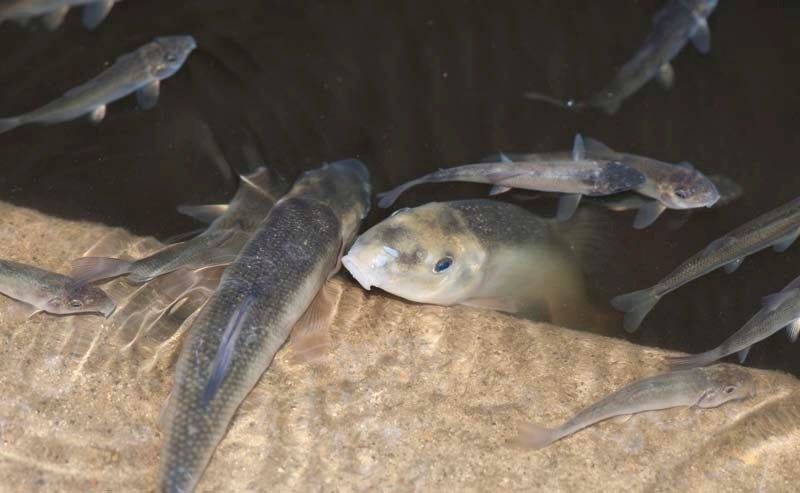Aug. 9, 2009 was the day I had one of the most magical wildlife encounters in many years of exploring the Sturgeon River.
Aug. 9, 2009 was the day I had one of the most magical wildlife encounters in many years of exploring the Sturgeon River.
I was zipping along on my bike underneath the Perron Street bridge when I noticed something splashing in a puddle where the river had overflowed onto the sidewalk.
When I slowed down to avoid the water, I realized that the splashes weren't the results of water dripping from above, as I had thought, but from something in the water itself: fish! A whole school of tiny fish, the biggest no longer than the length of my hand, were swimming up out of the river and wriggling in the shallows.
It was astonishing. There were at least 50 of the tiny fingerlings in this puddle no deeper than the width of my thumb, happily schooling about, briefly scattering when an errant foot disturbed the surface.
The fish would dip in and out of the river, hauling their silvery selves over the concrete lip. A few were so big that their top halves stuck out of the water, their bellies rubbing the ground as they struggled ashore.
The fish milled about my feet as I stood in their midst. The water was so clear that they seemed to swim through the air itself.
What I remembered most about them were the big lips on their huge, sucker-like mouths – a trait that helped me identify them as white suckers.
White sucker
The white sucker is one of the 13 species of fish known to frequent the Sturgeon River, according to the 2012 State of the Sturgeon Report.
Found pretty much everywhere outside of Alberta's mountains, these durable fish are known for their big sucker-like mouths and their ability to survive harsh water conditions. Researchers often use them as pollution detectors due to their durability, Fisheries and Oceans Canada reports.
Look for a fish with a dark back, silvery sides and possibly a black band on its side, says Mark Steinhilber, acting natural history director and at the Royal Alberta Museum. It'll have a sucker-like mouth right under its snout, big fleshy lips and no teeth. You'll often find scores of them in the shallows, he adds.
Robert MacDonald of Wildlife Control Services Ltd. says he's been fascinated with white suckers ever since he was a kid.
“It was the very first fish I ever captured,” he says.
He's been studying white sucker in the Sturgeon watershed this summer to research his upcoming book on the non-game fish of Alberta.
You might confuse the white sucker with the longnose sucker, as the two species hang out where the Sturgeon meets the North Saskatchewan, MacDonald says.
The longnose typically lacks a black stripe and has smaller scales than the white sucker, but they can be tough to tell apart as they often hybridize. Longnoses also get a bright red band during spawning season, Steinhilber says.
While they do eat algae, the white sucker prefers to feed on snails, molluscs, and other water creatures, Steinhilber says. Because it has no teeth, this involves sucking up any prey and crushing it in its digestive tract.
Living in often-turbid water, white suckers rely on scent and touch to hunt.
“The lips are very sensitive,” Steinhilber says.
White suckers are popular prey for other fish such as walleye and northern pike, MacDonald says. You'll typically spot them hiding under rocks or shuffling around pebbles in search of food.
White suckers are poorly studied compared to other sport fish, MacDonald says. We know little about their diets and wintering grounds, for example, or how best to catch them.
Yet many fishers deride them as “ugly” or “garbage” out of ignorance, he continues.
White suckers are much less bony than lake whitefish or northern pike, and have big flakes of white meat that go great with any recipe, he says. They can get up to five pounds in weight and average about one – a respectable catch for most fishers. They won't jump and splash on the line like some species, but will still put up a spirited fight, pulling like a bulldog.
“In Alberta we have only roughly 800 sustainable fishing lakes,” MacDonald says, and many of them are under great pressure.
By promoting non-game river fish like white sucker, he hopes to take some of the pressure off those lakes and other sport fish.
As for being ugly, they're downright beautiful compared to some salt-water species, he says.
“I'd have no problem kissing a suckerfish on a bet!”
White sucker
Name:
Catostomus commersoni. Sold commercially as "mullet."
Appearance:
Medium-sized fish with dark back and silvery sides. Key trait is the sucker mouth below the nose – it looks like it's making kissy-faces at you.
Commonly seen:
Shuffling around rocks in shallow lakes and rivers.
Occasionally confused with:
Longnose suckers, which look very similar and often interbreed with white suckers.
Fun fact:
They lay up to 50,000 eggs at once during spawning.
Wild St. Albert
Like wildlife? So do we! Every second Wednesday the Gazette profiles a reasonably common wild creature in the St. Albert region. Birds, beasts, bugs, fish … so long as it's alive and kicking, we'll feature it. <br /><br />Got a creature you'd like to see profiled? Send your suggestions to [email protected].




